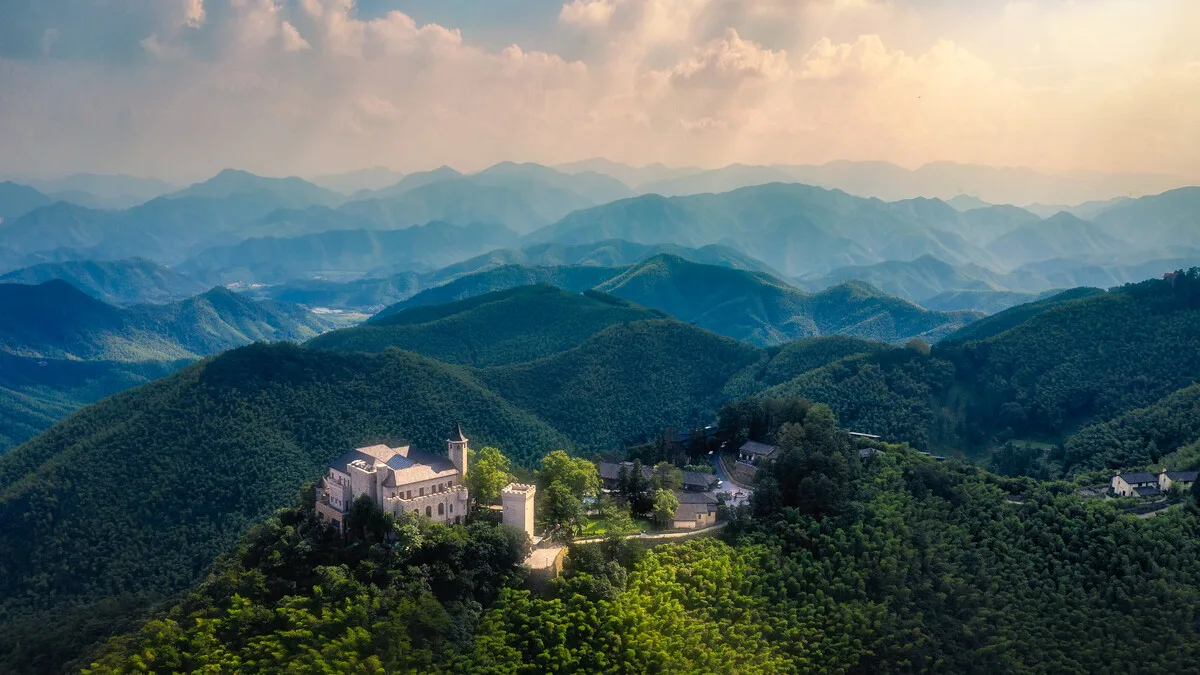Mogan Mountain Scenic Area (莫干山风景区), located in Huzhou, Zhejiang Province, is part of the Tianmu Mountain range. Covering approximately 4,000 acres, the area stretches 1.5 kilometers east to west and 1.25 kilometers north to south, with its highest peak, Tower Mountain, reaching an elevation of 758 meters. The mountain derives its name from the legendary tale of Gan Jiang and Mo Ye, master swordsmiths who forged a pair of unparalleled swords here during the late Spring and Autumn period.
The scenic area is divided into several distinct sections, including the Wuling Village Scenic Area, Sword Pond Scenic Area, and Reed Lake Park. The Great Pit Scenic Area is slightly farther away and accessible by vehicle, while other attractions are primarily explored on foot. The mountain is renowned for its architectural landscape, featuring over 200 villas and houses, earning it the nickname “World Architecture Museum.”
Mogan Mountain boasts a rich diversity of vegetation, with a forest coverage rate of 93.5%. It is home to 614 species of vascular plants across 136 families and 374 genera, including over ten nationally protected plant species and more than 200 ancient and notable trees. The dominant vegetation is bamboo, creating a unique and extensive bamboo sea landscape.
Table of Contents
- Basic Information
- Location and Transportation
- Highlights of Mogan Mountain Scenic Area
- Vlog about Mogan Mountain Scenic Area
Basic Information
| Estimated Length of Tour | 3 – 4 hours |
| Ticket Price | Admission: 80 RMB Admission + Sight-seeing Bus: 145 RMB |
| Opening Hours | 8.30 – 16.15 |
| Telephone Number | 0086-0572-8412345 |
Location and Transportation
Mogan Mountain Scenic Area is located in Deqing County, Huzhou, Zhejiang Province, and is part of the Tianmu Mountain range. The mountain runs in a northeast direction with central coordinates at 30°36′N latitude and 119°52′E longitude. It is approximately 82 kilometers from Hangzhou.
To reach Mogan Mountain, visitors can take a high-speed train to Deqing Station. From there, they can transfer to local buses such as Deqing 105, Deqing Y1, or B7, which provide direct routes to the Mogan Mountain Scenic Area.
Highlights of Mogan Mountain Scenic Area
The Villa Complex

The villa complex in Mogan Mountain is one of its most distinctive features. Most of these villas were constructed in the late 19th and early 20th centuries. There are over 200 Western-style rural villas, alongside a few classical Chinese buildings such as Huating, Huang Temple, and Linhai Villa. Additionally, more than 50 modern buildings have been constructed or renovated, including Mogan Villa, Cultural Venue, Post Office, Luhuadang Restaurant, Songliang Villa, Comprehensive Building, Wuling Hotel, Mogan Mountain Tax Collection and Rehabilitation Institute, Post and Telecommunications Rehabilitation Institute, Provincial Hydrology Training Center, Queen’s Hotel, and Baiyun Villa.
The old villas exhibit architectural styles from various countries, including the United States, Britain, France, Germany, and Russia, each with its unique charm. The architectural styles of these villas range from solemn and majestic to light and graceful, earning the villa complex the nicknames “World Architecture Museum” and “Small Villa Exhibition.”
Jianchi Waterfall

Jianchi Waterfall, also known as the Four-Tiered Waterfall, is a mesmerizing natural attraction hidden within the lush valleys of Yinshan Mountain. The waterfall’s journey begins upstream at the Fuxi Bridge, where two streams converge – one from Zhonghua Mountain and the other from Luhuadang. As these streams merge, their combined force flows swiftly down the gorge, creating the first tier of the waterfall that dramatically rushes towards the Fuxi Bridge.
After the bridge, the water plunges two to three more meters, forming the second tier of the waterfall as it cascades into Jianchi Pool. Here, the water momentarily gathers strength before descending from the pool into Jiantan, creating the third and most spectacular tier of the waterfall. This tier features a drop of over ten meters, creating a powerful and thunderous cascade. Finally, the water flows from Jiantan, forming a short fourth tier as it channels into the creek below.
Near the Jianchi Pool stands a bronze statue of Gan Jiang and Mo Ye, legendary swordsmiths, commemorating the origin of Mogan Mountain’s name. Visitors often take photos with this iconic sculpture, symbolizing their journey to this legendary site.
Luhuadang Park

Luhuadang Park is situated in Zhonghua Mountain, on the site of the former Jinzhong Temple. The temple, known for its frequent religious ceremonies involving gongs and drums, gave the area its original name, Luogutang (Hall of Gongs and Drums). After the temple was destroyed and reeds grew abundantly in its place, the area was renamed Luhuadang (Reed Blossom Pool).
The park features a circular entrance gate leading to an elliptical pool with a white crane sculpture. An elevated platform offers scenic views, with a circular pond on the left side filled with reeds and an open-air dance hall on the right. Two pavilions stand on either side of the platform, facing each other from a distance. The park is lush with greenery and includes a poetry stele corridor by Chen Yi, an animal zodiac garden, and Crane Peck Spring, adding to its serene and picturesque ambiance.


